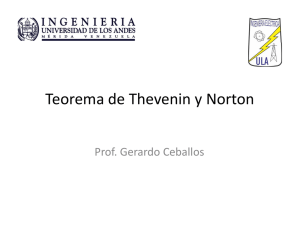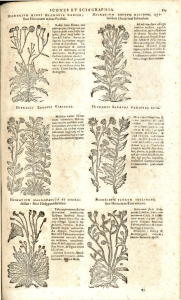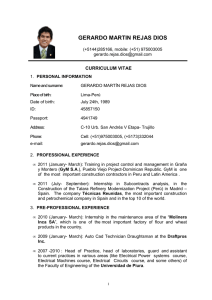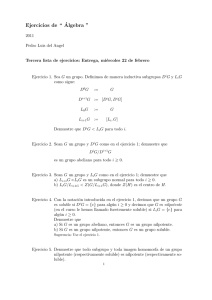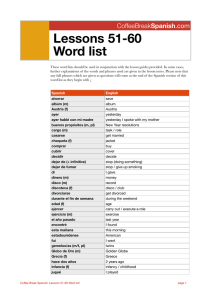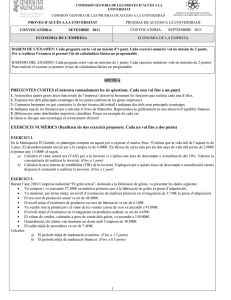Régimen Transitorio Circuito RL de Primer Orden
Anuncio
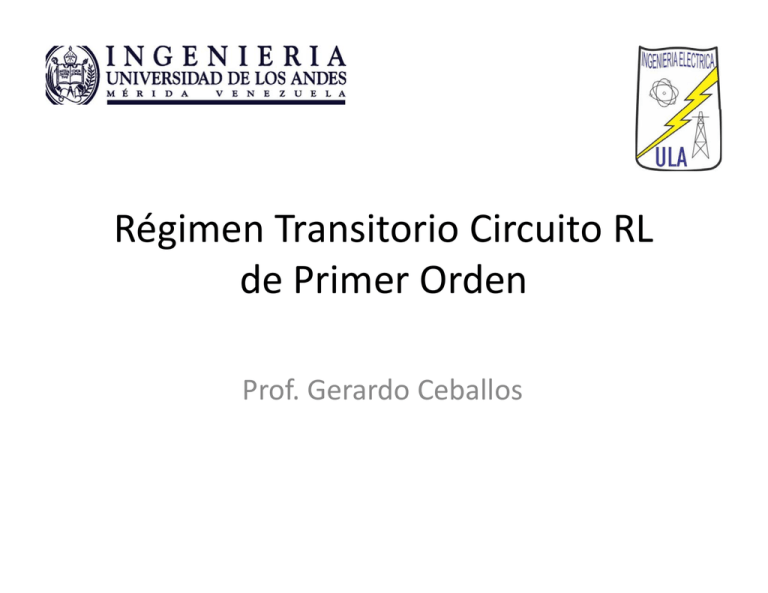
Régimen Transitorio Circuito RL de Primer Orden Prof. Gerardo Ceballos Inductor Prof. Gerardo Ceballos Inductor di L vL = L dt i v t 0 t 1 iL (t ) = iL (t 0 ) + ∫ v L (τ )dτ L t0 Régimen Permanente t Prof. Gerardo Ceballos Capacitor vs. Inductor Capacitor vs. Inductor i Régimen Permanente v 0 Prof. Gerardo Ceballos Análisis del circuito RL de 1er orden VL Ig = + iL R L diL Ig = + iL R dt diL R R + iL = I g dt L L Ec. Diferencial de 1er Orden iL (t ) = iL h (t ) + iL p (t ) Respuesta transitoria (Sol . De la ec. dif. homogénea) Prof. Gerardo Ceballos Respuesta forzada o particular (S l D l (Sol . De la ec. dif. particular) dif ti l ) iL (t ) = iL h (t ) + iL p (t ) Sol. Homogénea: Ame mt + R mt Ae = 0 L Sol. Particular: de la misma forma que Φ (t ) = dK R R + K = Ig dt L L R Ig L iL (t ) = Ae t L R + Ig ( ) + A = iL 0 − I g iL p (t ) = K iL p (t ) = I g K = Ig ( ) iL h (t ) = Ae 1 m=− L R Para hallar A se usan las condiciones iniciales: Para hallar A se usan las condiciones iniciales: − iL h (t ) = Ae mt diL R + iL = 0 dt L A≠0 e mt ≠ 0 iL 0 + = Ae − 0 L R iL (∞) = I g = I N + Ig Si R > 0 ( − ) iL (t ) = iL (∞) + iL (0 + ) − iL (∞) e Prof. Gerardo Ceballos t L R − t L R Constante de tiempo ( ) − iL (t ) = iL (∞) + iL (0 + ) − iL (∞) e Leqq τ= t s = 5τ RTh Régimen permanente Transitorio t Leq RTh Régimen permanente iL (∞) iL (0+ ) ( ) 0,99 iL (∞)+− iL (0 + ) 0,98 iL (∞+) − iL (0 ) 0,95 iL (∞+) − iL (0 ) 0,86 iL (∞) +− iL (0 ) 0,63 iL (∞) − iL (0 ) ( ( ( ) Prof. Gerardo Ceballos ( ) ) ) Pasos para analizar un circuito RL de p primer orden t ( x (t ) = x (∞) + (x (0 − ) ) − x (∞) )e iL (t ) = iL (∞) + iL (0 + ) − iL (∞) e c c c + Leq − c RTh t Leq RTh • Analizar en t=0‐ p para hallar iL((0‐), ), se puede p modelar el inductor como un corto. • Analizar en t=0+, donde iL(0+)=iL(0‐), se puede modelar al inductor como una fuente de corriente con valor iL(0+) • Analizar para t>0 – Equivalente de Norton, IN= iL(∞), τ=Leq /Rth Prof. Gerardo Ceballos Ejercicio • Hallar y graficar iL(t) y Vf(t) Prof. Gerardo Ceballos Ejercicio • t=0‐ : + 100 − 40 − 3ki + 1ki = 0 − V f + 4k (2i ) + 1ki + 100 = 0 i (0 − ) = 30mA V f (0 − ) = 370V Prof. Gerardo Ceballos iL (0 − ) = 60mA Ejercicio • t=0+ : I 4m I 2m I1m 2kI1m + 1kI 2m − 1kI 3m I 2m − I1m = 2i + 1kI 4m = −60 − I1m + I 2m + 2 I 4m = 0 I 2m − I 4m = 60mA I 3m V f (0 + ) = 40 − 2kI1m − 4k ( I1m − I 4m ) V f (0 + ) = −21,3V iL (0 + ) = iL (0 − ) = 60mA − 1kI 2m + 2kI 3m = 100 Prof. Gerardo Ceballos Equivalente de Norton que ve el inductor: • t>0 : I 4m I1m 6kI1m + 5kI 2m − 1kI 3m − 8kI 4m = −60 − V p I 2m − I1m = 2i − I1m + I 2m + 2 I 4m = 0 − 1kI 2m + 2kI 3m = 100 − 4kI1m − 4kI 2m VTh = V p I =I m 2 m 4 + 9kI 4m I 3m I 2m V f (∞) = 56,47V = Vp = 9,33V VTh RTh = = 5,69kΩ IN V f (∞) = 40 − 2kI1m − 4k ( I1m − I 4m ) I N = I 2m − I 4m V p =0 = 1,64mA Prof. Gerardo Ceballos V p =0 Ejercicio IN ( IN ) iL (t ) = iL (∞) + iL (0 ) − iL (∞) e + − t L iL (t ) = 1,64mA + (60mA − 1,64mA)e ( ) − V f (t ) = V f (∞) + V f (0 ) − V f (∞) e + V f (t ) = 56,47 + (− 21,3 − 56,47 )e V f (0 − ) = 370V 58,3mA t L − RTh t 25 μ τ= L 114mH = 20μs = RTh 5,69kΩ t s = 5τ = 5.20μs = 100μs ‐77,7V Prof. Gerardo Ceballos RTh t − 20 μ Simulado en Pspice Simulado en Pspice Prof. Gerardo Ceballos Ejercicio ( ) iL (t ) = iL (∞) + iL (0 ) − iL (∞) e + − t L iL (t ) = 1,64mA + (60mA − 1,64mA)e 58,3mA τ = 20μs RTh − t 20 μ t s = 100 μs Prof. Gerardo Ceballos Ejercicio ( ) − t L V f (t ) = V f (∞) + V f (0 ) − V f (∞) e t RTh − + V f (t ) = 56,47 + (− 21,3 − 56,47 )e V f (0 − ) = 370V 25 μ t s = 100 μs τ = 20μs ‐77,7V Prof. Gerardo Ceballos • Ver Ver en la página web ejercicio de resistencia en la página web ejercicio de resistencia negativa con inductor • Ver en la página web ejercicio de inductores Ver en la página web ejercicio de inductores en paralelo con condiciones iniciales Prof. Gerardo Ceballos
